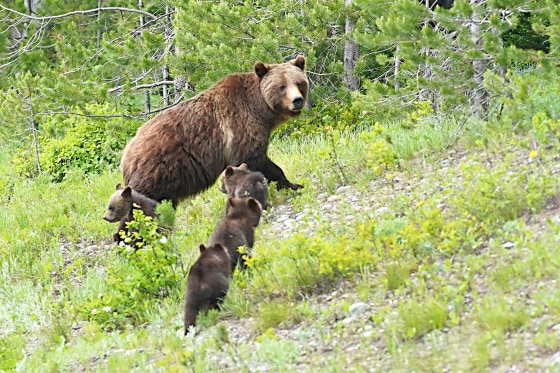The bear known as Grizzly 399, whom PBS dubbed the "most famous grizzly in the world," was killed Tuesday evening after she was hit by a car in Wyoming, officials said.
The U.S. Fish and Wildlife Service said the bear was identified through her microchip after she was hit on a highway in Snake River Canyon near Jackson, Wyoming. There was no indication that a cub that was with her was involved in the accident, it said.
Grizzly 399 was an iconic resident of Grand Teton National Park, near Yellowstone National Park. Grand Teton National Park Superintendent Chip Jenkins described her as one of the animals that make the area's national park ecosystem "so extraordinary."
"Grizzly bear 399 has been perhaps the most prominent ambassador for the species," Jenkins said in a statement. "She has inspired countless visitors into conservation stewardship around the world and will be missed."
The 28-year-old grizzly, which was one of the most photographed bears at the park, was the oldest known reproducing female grizzly bear in the greater Yellowstone park system. She gave birth to 18 cubs, though only eight have reached adulthood.
PBS dedicated an episode of its "Nature" series to Grizzly 399 in May, titling it "Grizzly 399: Queen of the Tetons." Trevor Bloom, a wildlife biologist at the University of Washington, noted in the episode that she was seen raising four cubs, which he noted was "rare" for bears.
"That's like a human having quadruplets," Bloom said.
American nature photographer Thomas D. Mangelsen first saw Grizzly 399 in May 2006, an exciting but fleeting moment for him. He was among the first to photograph the bear and her cubs, which kick-started years of documenting her through the lens.
He told Stanford University in 2021 that Grizzly 399 became the "poster child" of bear conservation. Grizzlies are a protected class as a threatened species, but they are not considered endangered.
Grizzlies, a subspecies of brown bears, thrived in North America before the early 1800s, but their populations became threatened by European colonizers who believed them to be a danger. According to the U.S. Fish and Wildlife Service, the species was reduced to 2% of its population by the 1930s, and by 1975 there were only upward of 800 bears in the contiguous 48 states.
Protections have been established to help the bear population rise, and now there are an estimated 1,923 in the contiguous U.S., the wildlife service said.
